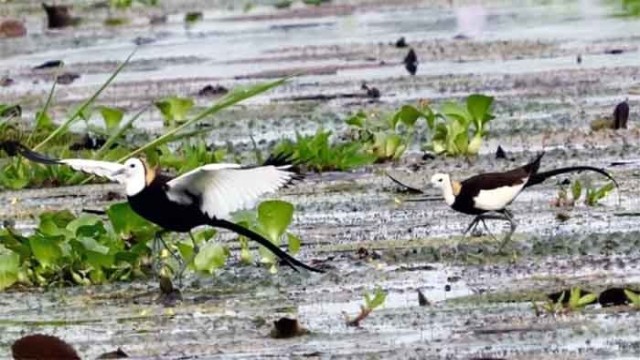Tangail, July 6 (V7N) – The rare and visually striking watercock, a bird native to Bangladesh, has recently been spotted in Tangail’s Ghatail upazila by amateur photographer Kamal Hossain. Despite its name, the watercock is not related to the peafowl and bears no resemblance to it. This elusive bird primarily feeds on grains, aquatic fruits, and insects, inhabiting wetlands such as beels, haors, and large water bodies.
The watercock measures 39 to 58 centimeters in length, including its distinctive 25-centimeter-long tail. Males weigh between 113 to 135 grams, while females are heavier, ranging from 205 to 260 grams. These birds live in freshwater wetlands and tend to roam singly or in pairs during summer, forming flocks in winter. They forage by walking on floating vegetation, feeding on aquatic insects, soft plant shoots, sprouts, and seeds.
There are three recognized subspecies of the watercock: the Common Watercock (Gallicrex cinerea), the Lesser Watercock (Gallicrex pusilla), and the Swamp Watercock or Mewa. The International Union for Conservation of Nature (IUCN) classifies the watercock as a species of Least Concern, but local threats persist.
Kamal Hossain described the serene experience of capturing the watercock in its natural habitat, noting that he patiently waited over two hours at Ranadah Beel in Dewpara Union before successfully photographing the bird. He observed a pair engaging in playful behavior on floating plants, while another bird called out from a nearby leaf. According to him, the presence of aquatic plants like water lilies and lotus leaves in the beel supports the watercock population, but urgent conservation measures are needed. Without protection from hunting and habitat encroachment, the species could soon disappear from the area.
Experts explain that during the breeding season, the watercock becomes especially vibrant. Breeding males exhibit white feathers on the head, neck, and wings, with golden-yellow necks, dark brown backs, and dusky brown chests and bellies. A dark brown stripe separates the white and yellow plumage, while the beak turns bluish and the legs are bluish-black. Both males and females appear similar. Nesting occurs on floating vegetation such as water lilies and lotus leaves, where the female lays four glossy olive-brown eggs. The male solely incubates the eggs for 23 to 26 days, and the chicks are precocial—able to walk, swim, and dive soon after hatching. The male continues to care for the young for approximately two months.
Forest Department officials and ornithologists warn that the watercock’s traditional habitats in hill wetlands are increasingly threatened by illegal hunting, habitat destruction, and pesticide use. Local teacher Zainal Abedin lamented that Ranadah Beel, once rich in biodiversity alongside nearby Kaliyan Beel and Gojari Forest, is now fragmented by roads and encroachment. The use of illegal fishing nets such as Chinese and current nets has devastated fish and aquatic life, further endangering the ecosystem.
Sustained conservation efforts, including designating Ranadah Beel as a protected, hunting-free, and encroachment-free zone, are critical to preserving the fragile habitat of the watercock and the region’s overall biodiversity.
END/BKC/SMA/































Comment: